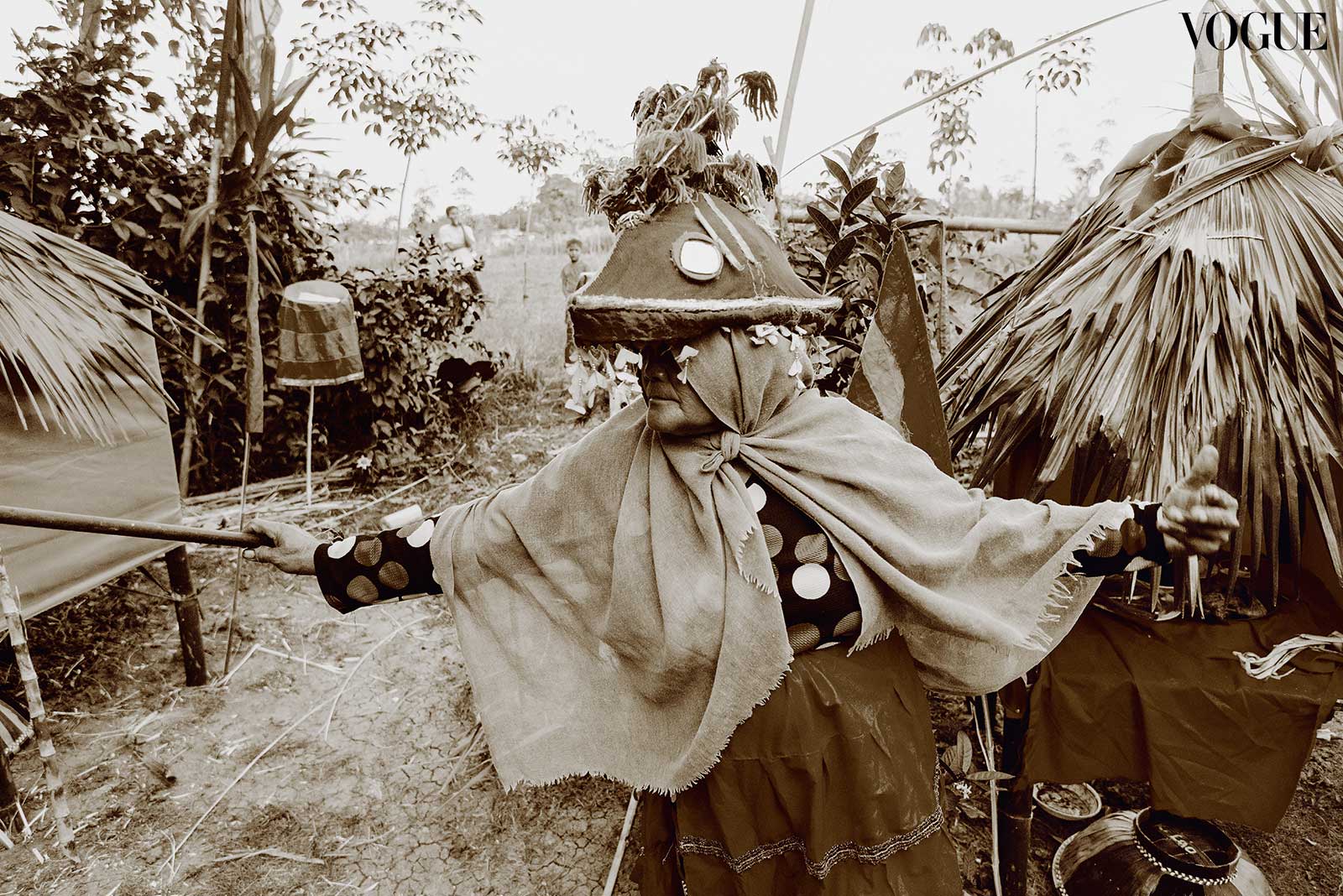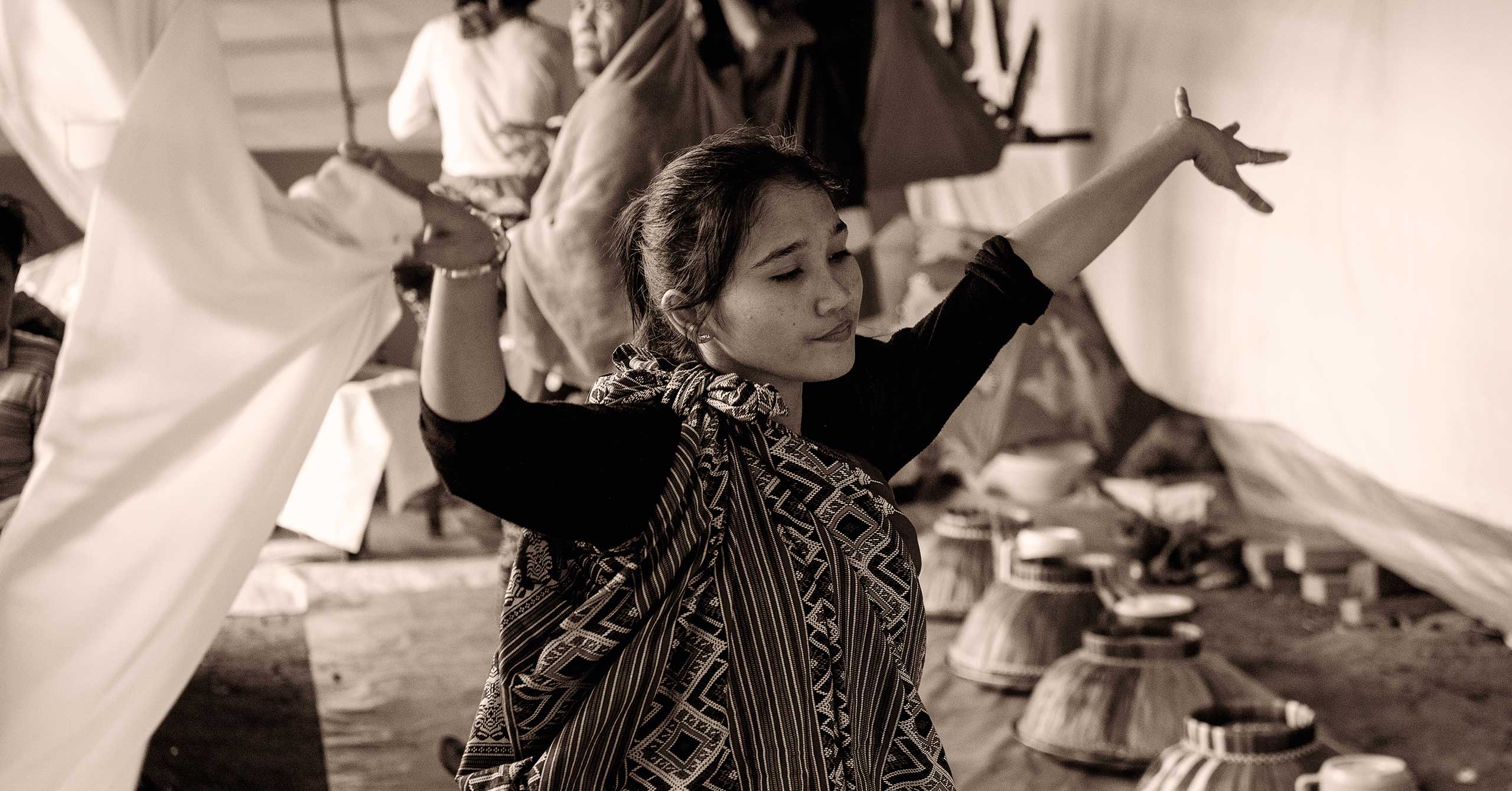Photo by Jacob Maentz
Participants in the Ipat ritual can enter into a trance-like state. Photo by Jacob Maentz. Photo by Jacob Maentz
To those who have experienced it, Maguindanao’s sacred tradition of the Ipat has become a path to personal growth and awareness.
As a Catholic almost half of my life, I believed I knew the depths of my faith. But it was an extraordinary awakening, a revelation that left me awe-inspired and humbled. In the heartland of Maguindanao, I experienced the Ipat ritual, a sacred tradition that predates the arrival of colonialism, Islam, and Christianity. It was a glimpse into the heritage that flowed through the veins of my ancestors. Surprisingly, it was my migration to the United States that ignited my awareness of culture more than ever before. The distance and separation from my homeland had an unexpected effect, drawing me closer to my roots and igniting an insatiable hunger to learn and embrace my culture. And so, it was through a life-changing tribal tour that I found myself standing on the precipice of transformation, forever touched by the profound power of the Ipat ritual.
A pivotal moment in my journey occurred in 2015 when I joined a tribal tour program led by Alleluia Panis of Kularts, a renowned presenter of Filipinx Contemporary Art in the US. She had been organizing these tours since the late 1980s, forging relationships with Indigenous communities across the country, even in places I had never imagined were on the Philippine map. Education in the Philippines, much like in the United States, often filters and selectively presents information, leaving me feeling deprived of crucial knowledge about my own ancestry. This tour became a catalyst for reconnecting with something that had been lost over generations of trauma. It initiated a profound process of my self-discovery. It emphasized the importance of cultural exploration, challenging societal narratives, and seeking a more profound understanding of my own identity as a Filipinx in the diaspora.
Part of the tour is through Maguindanao, which has been depicted by mainstream media as a dangerous warzone torn between the Islamic and Christian communities. As we drove through Iligan City from Lanao Lake, I couldn’t help but be on high alert. Recent massacres had occurred in the area, intensifying my fear. Although my parents were apprehensive, I felt an inner calling to embark on this adventure.
We ventured deep into the heart of Cotabato City where I learned about a sacred ritual known as Ipat, a three-and-a-half day ritual that has been in practice for many centuries by the Maguindanaoan people. This ceremony allowed me to embark on a transformative journey like no other.

The Ipat ritual holds deep cultural significance in Maguindanao, dating back centuries to the pre-colonial and pre-Islamic era. Derived from the Maguindanao word that means “to invoke or summon,” the Ipat is conducted by the community to seek protection, blessings, and guidance from ancestral spirits.
We gathered in a designated sacred space in a home near the Pulangi River where the homeowner allowed the community to set up their space, adorning it with beautiful inaul fabric, candles, and cloth of green, yellow and red (traditional Maguindanao colors). The shaman led the ceremony, invoking the spirits and connecting the physical and spiritual realms through chanting. The ritual involves offerings such as uncooked rice, popped rice, boiled eggs, delicacies, grilled and boiled native chicken, turmeric rice, and other symbolic items to appease the spirits and establish a spiritual connection. I learned that the ritual could last from seven to 30 days, but this one I participated in was a shorter version to accommodate the tour’s travels and to keep it subtle among the local society who may not understand much about the practice.’
Chants, kulintang [an instrument made of knobbed bronze gongs], and traditional dances accompany the ceremony, further heightening the spiritual ambiance. The participants were encouraged to wear a malong [a traditional Filipino-Bangsamoro garment] and engage in movements that symbolize their respect and reverence for the spirits.
As a participant and observer, Ipat was a celebration of cultural identity and solidarity. It reinforces the bonds among the community, reminding them of their living traditions and the wisdom passed down through oral history. Today, the ritual continues to be practiced, continuing the cultural legacy and spiritual traditions of Maguindanao. Islamic leaders and some government agencies have discouraged the practice of the ritual but the community found ways to keep the living tradition as part of their lives.
The Ipat ritual shares similarities with the Ayahuasca ceremony from Peru. Both aim to facilitate spiritual awakening and self-discovery. While Ayahuasca utilizes the properties of a plant-based psychedelic brew, Ipat relies on the mastery of the shaman’s chanting and their ability to guide participants through deep meditation, visualization, and energy manipulation. Unlike other ceremonies, Ipat does not rely on the support of mind-altering substances, just pure music, chanting, deep meditative movements and incense. It harnesses the power of indigenous wisdom and ancient techniques to induce a state of spiritual elevation. The absence of drugs highlights the belief in the inherent capability of the human mind to explore realms beyond the ordinary, allowing us to tap into our innate spiritual potential.
As I entered the space, the air was heavy with the fragrance of incense, creating a serene and meditative atmosphere. Soft chants, accompanied by kulintang music resonated throughout the surroundings, transporting me into a heightened state of awareness. The auditory stimulation played a crucial role in preparing my mind for the journey. Wearing vibrant malong, the Shaman guided me through a series of physical gestures and movement, symbolizing the connection between the earthly and the divine. This engagement fostered a profound sense of trust and intimacy, further deepening the overall experience.
Balance And Connection
The duality of shamans plays a vital role in the journey towards the divine. It encompasses the harmonious blend of masculine and feminine energies, symbolizing balance and the interconnectedness of all aspects of existence. This fusion allows for a holistic and inclusive approach, where both the light and shadow aspects of one’s being are acknowledged and embraced.
Patutunong are known to possess a unique duality that is both spiritual and physical. They are believed to have the ability to bridge the physical and spiritual realms, often reflected in their shamanistic practices. The balance of masculine and feminine energies is a fundamental aspect of shamanistic practices in the Philippines. It is believed that both energies are necessary to achieve a state of spiritual balance and harmony, and this balance is often reflected in their movements and the pitch of their chant. The duality is essential to their practice of the ceremony as they are able to channel their healing powers effectively and achieve a state of balance that is beneficial to the community.

The ritual incorporates the offering of uncooked rice, eggs, native chicken, and oils. These offerings symbolize gratitude and reverence for the divine forces at play. Uncooked rice represents fertility, abundance, and nourishment, while eggs symbolize new beginnings and the potential for growth. Native chicken signifies the spiritual connection between the earthly and celestial realms, while oils represent purification and healing.
Participants are asked to pick one offering to eat while doing a reading based on the Shaman’s interpretation of the offering picked. The fourth day is the finale where we send the spirits back to their homes. We were asked to be part of building a huge spiritual banquet offering for the spirits with rice shaped like a crocodile which is believed to be their spiritual ancestor along with hanging baki, a rice delicacy wrapped in coconut leaves. The huge offering also included freshly slaughtered native chicken, where the blood becomes part of the offering and the chicken is boiled and added to the banquet table each representing the number of participants attending the ceremony.
Central to the Ipat ritual is the presence of the biday, a symbolic boat that holds deep cultural significance. The biday represents the vessel of the self, sailing through the waters of existence toward spiritual enlightenment. It serves as a metaphorical vehicle, allowing us to traverse the boundaries of the physical realm and embark on a transformative voyage to the divine. It is swayed back and forth during the beginning and the end of the ceremony allowing the spirits to travel to the living world. During the last day, a small boat with offerings is sailed through the river as we wrap up this intense journey and say goodbye to the spirits.
The Ipat ritual is an extraordinary experience that allowed me to connect to the divine that had encouraged me to commit to doing it every other year. I’ve been doing it every other year since then. Every Shaman, household, family who hosts it has their different take and execution. It became a church or a little retreat for cleansing, healing and reconnecting to something that the Western society tends to separate me from. The ritual underscores the power of the human mind in exploring divine realms and highlights diverse spiritual paths. It was a doorway to my personal growth, self-awareness, and a profound connection with the sacred that I have never experienced before.
Writer’s note: I offer this article to Shaman Ismael who transitioned in March 2022. He has been an incredible resource and inspiration in this journey. May he rest in peace.

